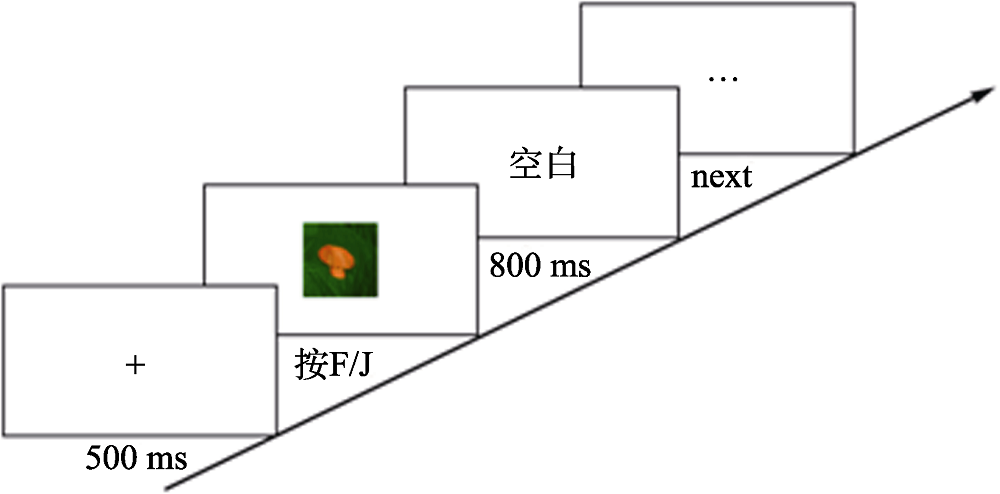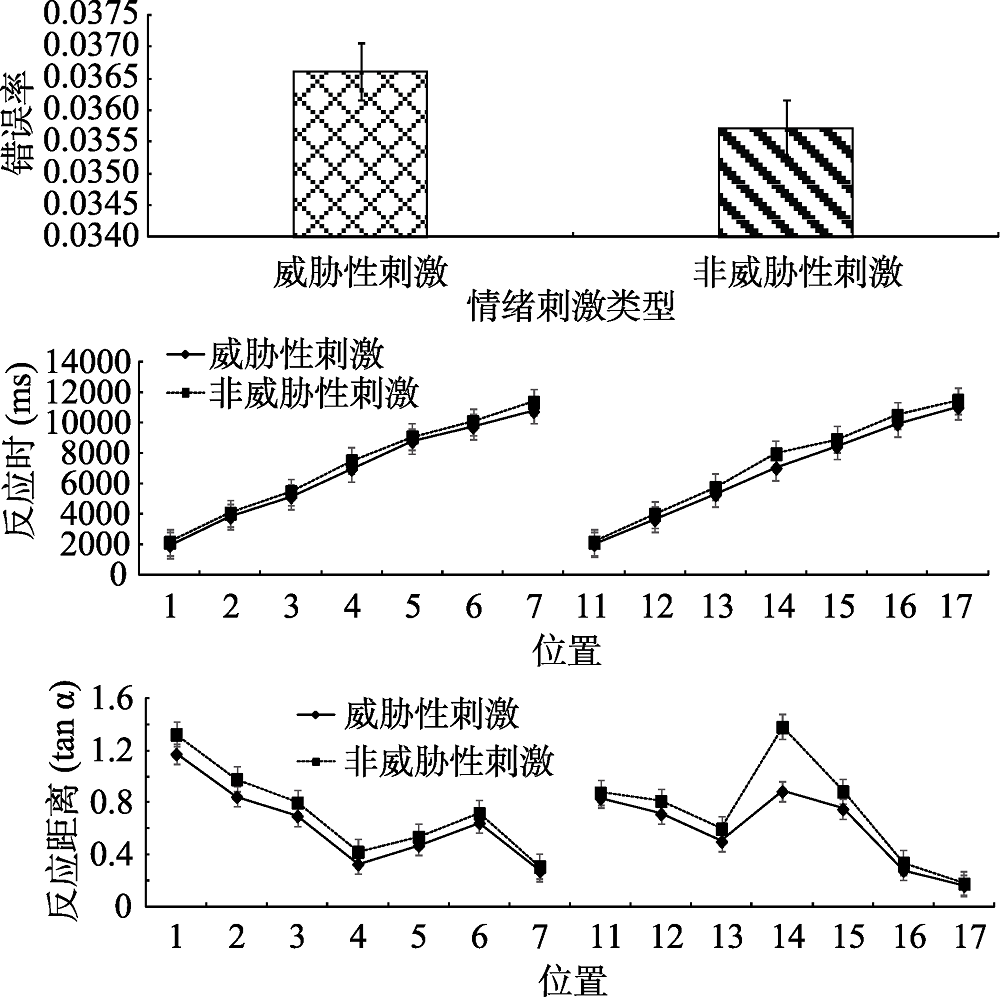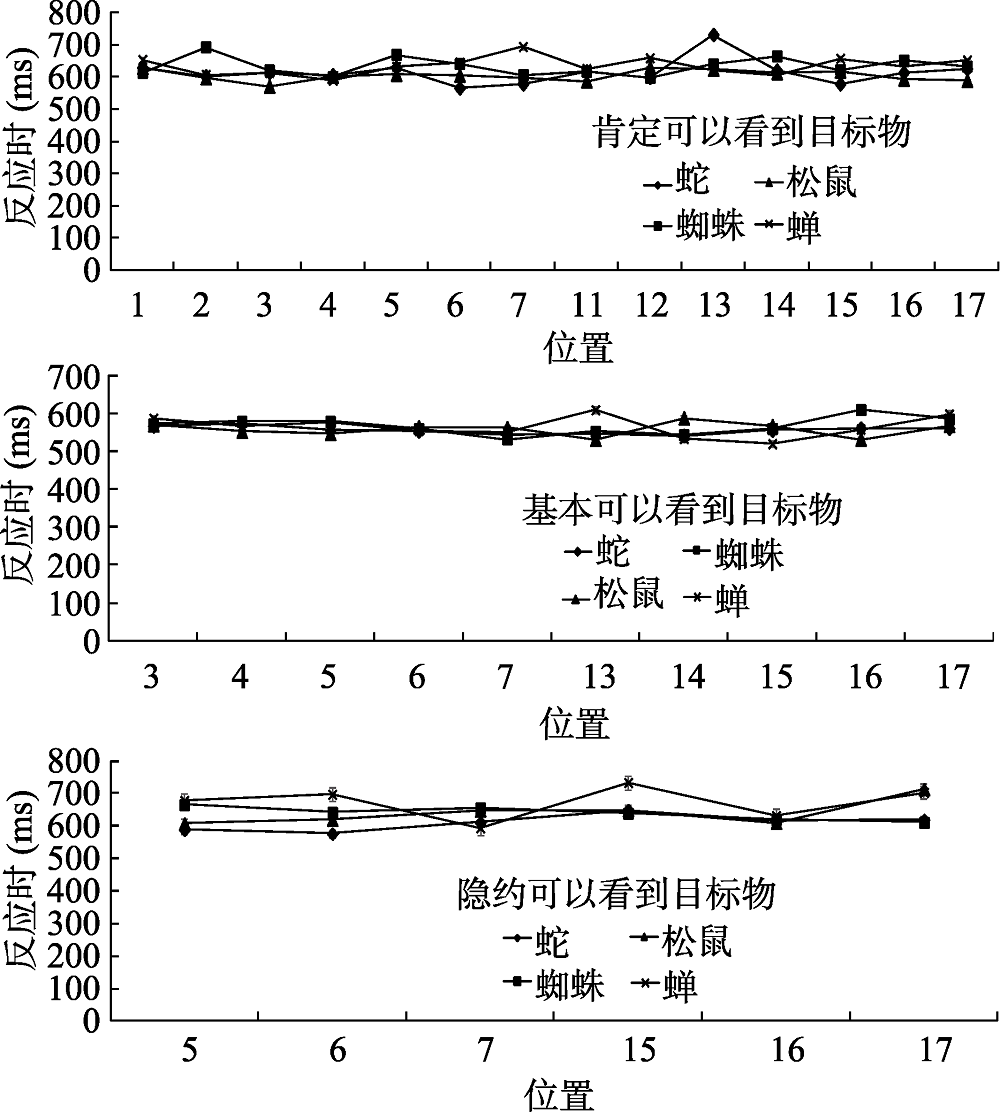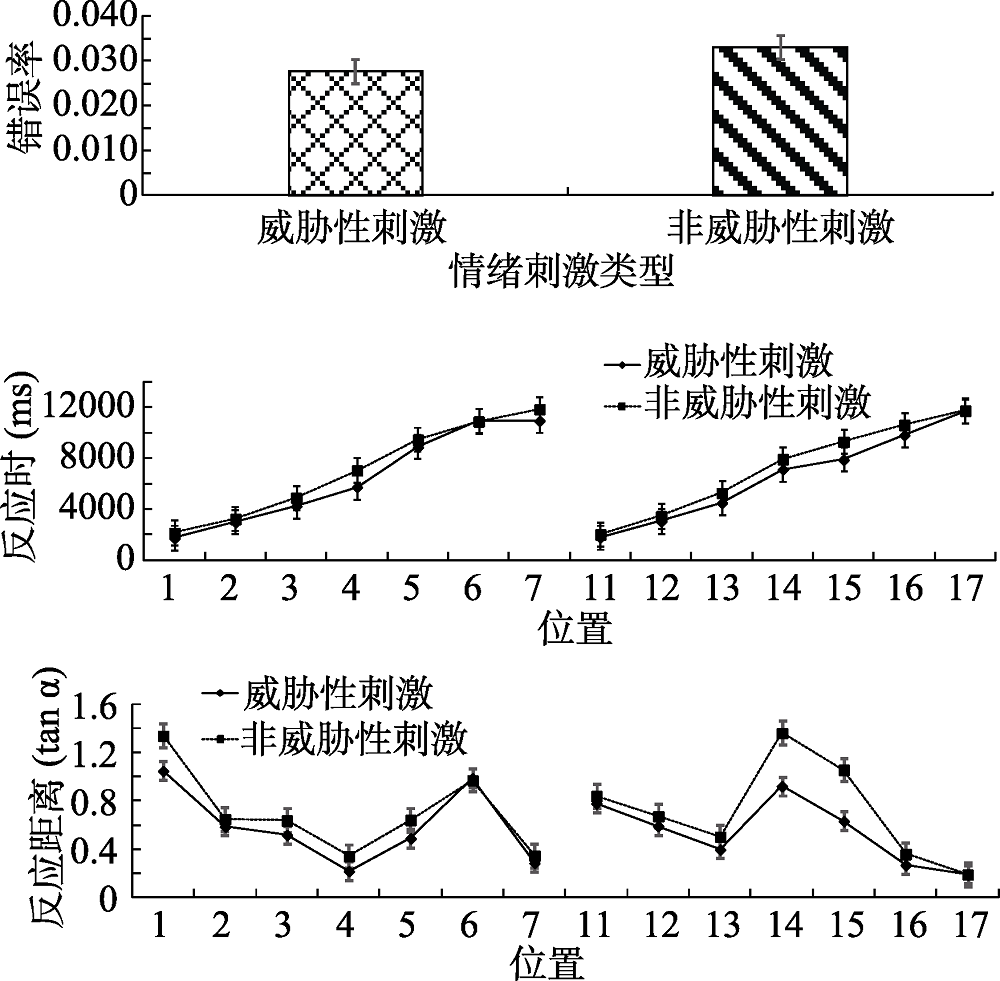 )
) 首都师范大学心理学院, 北京市“学习与认知”重点实验室, 北京 100048
收稿日期:2016-11-28出版日期:2018-06-01发布日期:2018-04-28通讯作者:汪亚珉E-mail:wangym@cnu.edu.cn基金资助:北京市教育委员会面上项目(KM201610028018);北京市教育委员会市属高校创新能力提升计划资助项目资助(TJSH20161002801)Attentional bias towards threatening visual stimuli in a virtual reality-based visual search task
YUAN Xiaojun, CUI Xiaoxia, CAO Zhengcao, KAN Hong, WANG Xiao, WANG Yamin( )
) Beijing Key Laboratory of “Learning & Cognition”, School of Psychology, Capital Normal University, Beijing 100048, China
Received:2016-11-28Online:2018-06-01Published:2018-04-28Contact:WANG Yamin E-mail:wangym@cnu.edu.cn摘要/Abstract
摘要: 自?hman,
图/表 14

图1视觉搜索实验中所使用的仿真丛林场景注:彩图见电子版, 下同
 图1视觉搜索实验中所使用的仿真丛林场景注:彩图见电子版, 下同
图1视觉搜索实验中所使用的仿真丛林场景注:彩图见电子版, 下同
图2搜索实验中所用刺激物模型及颜色对比注:依次为蛇、蜘蛛、花、蘑菇、松鼠、蝉, 其中花、蘑菇与蛇、蜘蛛匹配作为实验1的刺激材料, 松鼠、蝉与蛇、蜘蛛匹配作为实验2的材料。
 图2搜索实验中所用刺激物模型及颜色对比注:依次为蛇、蜘蛛、花、蘑菇、松鼠、蝉, 其中花、蘑菇与蛇、蜘蛛匹配作为实验1的刺激材料, 松鼠、蝉与蛇、蜘蛛匹配作为实验2的材料。
图2搜索实验中所用刺激物模型及颜色对比注:依次为蛇、蜘蛛、花、蘑菇、松鼠、蝉, 其中花、蘑菇与蛇、蜘蛛匹配作为实验1的刺激材料, 松鼠、蝉与蛇、蜘蛛匹配作为实验2的材料。
图3丛林草地上的路径及对所搜索目标物(蘑菇)进行评定时的3种条件注:固定路径摄像机行走的是中间的直线, 在小径的任意行走点上, 被试看到目标物的视线与固定路径之间的夹角为α
 图3丛林草地上的路径及对所搜索目标物(蘑菇)进行评定时的3种条件注:固定路径摄像机行走的是中间的直线, 在小径的任意行走点上, 被试看到目标物的视线与固定路径之间的夹角为α
图3丛林草地上的路径及对所搜索目标物(蘑菇)进行评定时的3种条件注:固定路径摄像机行走的是中间的直线, 在小径的任意行走点上, 被试看到目标物的视线与固定路径之间的夹角为α
图4反应距离计算示意图
 图4反应距离计算示意图
图4反应距离计算示意图表1丛林搜索场景与国外虚拟现实游戏场景IGROUP评定结果比较
| 因子 | 丛林搜索场景 | Tomb Raider | Half Life |
|---|---|---|---|
| 存在感 | 3.83 | 3.00 | 3.93 |
| 空间存在感 | 3.83 | 3.06 | 3.99 |
| 沉浸感 | 3.31 | 2.40 | 3.26 |
| 真实感体验 | 3.04 | 1.92 | 2.34 |
表1丛林搜索场景与国外虚拟现实游戏场景IGROUP评定结果比较
| 因子 | 丛林搜索场景 | Tomb Raider | Half Life |
|---|---|---|---|
| 存在感 | 3.83 | 3.00 | 3.93 |
| 空间存在感 | 3.83 | 3.06 | 3.99 |
| 沉浸感 | 3.31 | 2.40 | 3.26 |
| 真实感体验 | 3.04 | 1.92 | 2.34 |

图5刺激评定实验流程图
 图5刺激评定实验流程图
图5刺激评定实验流程图
图6物理显著性分析示意图
 图6物理显著性分析示意图
图6物理显著性分析示意图
图7实验1刺激材料评定实验反应时结果
 图7实验1刺激材料评定实验反应时结果
图7实验1刺激材料评定实验反应时结果表2不同位置反应时最小值(平均数、标准误)
| 位置 | 平均数(ms) | 标准误 |
|---|---|---|
| 位置5 | 5306.80 | 122.41 |
| 位置6 | 5997.55 | 138.11 |
| 位置7 | 6912.65 | 119.33 |
| 位置15 | 4935.95 | 109.64 |
| 位置16 | 5983.80 | 101.94 |
| 位置17 | 6612.70 | 141.75 |
表2不同位置反应时最小值(平均数、标准误)
| 位置 | 平均数(ms) | 标准误 |
|---|---|---|
| 位置5 | 5306.80 | 122.41 |
| 位置6 | 5997.55 | 138.11 |
| 位置7 | 6912.65 | 119.33 |
| 位置15 | 4935.95 | 109.64 |
| 位置16 | 5983.80 | 101.94 |
| 位置17 | 6612.70 | 141.75 |

图8实验1视觉搜索实验被试错误率、反应时、反应距离(平均数±标准误)结果
 图8实验1视觉搜索实验被试错误率、反应时、反应距离(平均数±标准误)结果
图8实验1视觉搜索实验被试错误率、反应时、反应距离(平均数±标准误)结果
图9实验2刺激材料评定实验反应时结果
 图9实验2刺激材料评定实验反应时结果
图9实验2刺激材料评定实验反应时结果
图10实验2视觉搜索实验被试错误率、反应时、反应距离(平均数±标准误)结果
 图10实验2视觉搜索实验被试错误率、反应时、反应距离(平均数±标准误)结果
图10实验2视觉搜索实验被试错误率、反应时、反应距离(平均数±标准误)结果表3图片物理显著性的明度值平均数(括号内为标准误)
| 实验 | 蛇 | 蜘蛛 | 花 | 蘑菇 | 松鼠 | 蝉 |
|---|---|---|---|---|---|---|
| 实验1 | 0.605 (0.002) | 0.606 (0.002) | 0.605 (0.002) | 0.602 (0.002) | ||
| 实验2 | 0.605 (0.002) | 0.606 (0.002) | 0.611 (0.002) | 0.605 (0.002) |
表3图片物理显著性的明度值平均数(括号内为标准误)
| 实验 | 蛇 | 蜘蛛 | 花 | 蘑菇 | 松鼠 | 蝉 |
|---|---|---|---|---|---|---|
| 实验1 | 0.605 (0.002) | 0.606 (0.002) | 0.605 (0.002) | 0.602 (0.002) | ||
| 实验2 | 0.605 (0.002) | 0.606 (0.002) | 0.611 (0.002) | 0.605 (0.002) |

图11实验中所用模型在搜索局部场景中的显著性上:实验1模型显著性, 下:实验2模型显著性)
 图11实验中所用模型在搜索局部场景中的显著性上:实验1模型显著性, 下:实验2模型显著性)
图11实验中所用模型在搜索局部场景中的显著性上:实验1模型显著性, 下:实验2模型显著性)参考文献 43
| [1] | Buss, D. M . ( 1999). Evolutionary psychology: The new science of the mind. Boston: Allyn and Bacon. |
| [2] | Cisler J. M., Bacon A. K., & Williams N. L . ( 2009). Phenomenological characteristics of attentional biases towards threat: A critical review. Cognitive Therapy & Research, 33(2), 221-234. doi: 10.1007/s10608-007-9161-yURLpmid: 2901130 |
| [3] | Cisler J. M., & Koster E. H. W . ( 2010). Mechanisms of attentional biases towards threat in anxiety disorders: An integrative review. Clinical Psychology Review, 30(2), 203-216. doi: 10.1016/j.cpr.2009.11.003URLpmid: 2814889 |
| [4] | Dudeney J., Sharpe L., & Hunt C . ( 2015). Attentional bias towards threatening stimuli in children with anxiety: A meta-analysis. Clinical Psychology Review, 40, 66-75. doi: 10.1016/j.cpr.2015.05.007URLpmid: 26071667 |
| [5] | Felnhofer A., Kothgassner O. D., Schmidt M., Heinzle A. K., Beutl L., Hlavacs H., & Kryspin-Exner I . ( 2015). Is virtual reality emotionally arousing? Investigating five emotion inducing virtual park scenarios. International Journal of Human-Computer Studies, 82, 48-56. doi: 10.1016/j.ijhcs.2015.05.004URL |
| [6] | Gibson, J. J . ( 1979). The ecological approach to visual perception. Boston, MA: Houghton Mifflin. doi: 10.1080/00071773.1982.11007570URL |
| [7] | Hansen C. H., & Hansen R. D . ( 1988). Finding the face in the crowd: An anger superiority effect. Journal of Personality & Social Psychology, 54(6), 917-924. doi: 10.1037/0022-3514.54.6.917URLpmid: 3397866 |
| [8] | Itti L., & Koch C . ( 2000). A saliency-based search mechanism for overt and covert shifts of visual attention. Vision Research, 40(10-12), 1489-1506. doi: 10.1002/jid.1310URLpmid: 1078865422 |
| [9] | Janczyk M., Augst S., & Kunde W . ( 2014). The locus of the emotional Stroop effect: A study with the PRP paradigm. Acta Psychologica, 151, 8-15. doi: 10.1016/j.actpsy.2014.05.011URLpmid: 24904999 |
| [10] | Juth P., Lundqvist D., Karlsson A., & ?hman A . ( 2005). Looking for foes and friends: Perceptual and emotional factors when finding a face in the crowd. Emotion, 5(4), 379-395. doi: 10.1037/1528-3542.5.4.379URLpmid: 16366743 |
| [11] | Ledoux, J. E . ( 2000). Emotion circuits in the brain. Annual Review of Neuroscience, 23, 155-184. |
| [12] | Lee D. N., & Kalmus H . ( 1980). The optic flow field: The foundation of vision [and discussion]. Philosophical Transactions of the Royal Society B: Biological Sciences, 290(1038), 169-179. |
| [13] | Lindsay P. H. , & Norman, D. A.( 1977) . Human information processing: An introduction to psychology New York: Academic Press An introduction to psychology. New York: Academic Press. |
| [14] | LoBue, V. ( 2010). And along came a spider: An attentional bias for the detection of spiders in young children and adults. Journal of Experimental Child Psychology, 107(1), 59-66. doi: 10.1016/j.jecp.2010.04.005URLpmid: 20529694 |
| [15] | LoBue V., & Rakison D. H . ( 2013). What we fear most: A developmental advantage for threat-relevant stimuli. Developmental Review, 33(4), 285-303. doi: 10.1016/j.dr.2013.07.005URL |
| [16] | Matsumoto, E. ( 2010). Bias in attending to emotional facial expressions: Anxiety and visual search efficiency. Applied Cognitive Psychology, 24(3), 414-424. doi: 10.1002/acp.1686URL |
| [17] | Mogg K., & Bradley B. P . ( 2006). Time course of attentional bias for fear-relevant pictures in spider-fearful individuals. Behaviour Research & Therapy, 44(9), 1241-1250. doi: 10.1016/j.brat.2006.05.003URLpmid: 16870133 |
| [18] | Mogg K., Bradley B. P., & Hallowell N . ( 1994). Attentional bias to threat: Roles of trait anxiety, stressful events, and awareness. The Quarterly Journal of Experimental Psychology Section A: Human Experimental Psychology, 47(4), 841-864. doi: 10.1080/14640749408401099URLpmid: 7809399 |
| [19] | ?hman, A. ( 2009). Of snakes and faces: An evolutionary perspective on the psychology of fear. Scandinavian Journal of Psychology, 50(6), 543-552.?hman, A., Flykt, A., & Esteves, F. (2001). Emotion drives attention: Detecting the snake in the grass. Journal of Experimental Psychology: General, 130(3), 466-478. |
| [20] | ?hman A., Lundqvist D., & Esteves F . ( 2001). The face in the crowd revisited: A threat advantage with schematic stimuli. Journal of Personality & Social Psychology, 80(3), 381-396. |
| [21] | ?hman A., & Mineka S . ( 2001). Fears, phobias, and preparedness: Toward an evolved module of fear and fear learning. Psychological Review, 108, 483-522. |
| [22] | ?hman A., Soares S. C., Juth P., Lindstr?m B., & Esteves F . ( 2012). Evolutionary derived modulations of attention to two common fear stimuli: Serpents and hostile humans. Journal of Cognitive Psychology, 24(1), 17-32. doi: 10.1080/20445911.2011.629603URL |
| [23] | Peira N., Golkar A., ?hman A., Anders S., & Wiens S . ( 2012). Emotional responses in spider fear are closely related to picture awareness. Cognition and Emotion, 26(2), 252-260. doi: 10.1080/02699931.2011.579087URLpmid: 21973031 |
| [24] | Peng D. L. ( 2012). General psychology (4th ed.) . Beijing, China: Beijing Normal University Press. |
| [ 彭聃龄 . ( 2012). 普通心理学 (第4版). 北京: 北京师范大学出版社.] | |
| [25] | Savage R. A., Lipp O. V., Craig B. M., Becker S. I., & Horstmann G . ( 2013). In search of the emotional face: Anger versus happiness superiority in visual search. Emotion, 13(4), 758-768. doi: 10.1037/a0031970URLpmid: 23527503 |
| [26] | Schubert T., Friedmann F., & Regenbrecht H . ( 2001). The experience of presence: Factor analytic insights. Presence, 10(3), 266-281. doi: 10.1162/105474601300343603URL |
| [27] | Soares, S. C . ( 2012). The lurking snake in the grass: Interference of snake stimuli in visually taxing conditions. Evolutionary Psychology, 10(2), 187-197. doi: 10.1177/147470491201000202URLpmid: 22947633 |
| [28] | Soares S. C., Esteves F., Lundqvist D., & ?hman A . ( 2009). Some animal specific fears are more specific than others: Evidence from attention and emotion measures. Behaviour Research & Therapy, 47(12), 1032-1042. doi: 10.1016/j.brat.2009.07.022URLpmid: 19695561 |
| [29] | Soares S. C., Lindstr?m B., Esteves F., & ?hman A . ( 2014). The hidden snake in the grass: Superior detection of snakes in challenging attentional conditions. PLoS One, 9(12), e114724. doi: 10.1371/journal.pone.0114724URLpmid: 4262429 |
| [30] | Stormark K. M., & Hugdahl K . ( 1996). Peripheral cuing of covert spatial attention before and after emotional conditioning of the cue. International Journal of Neuroscience, 86(3-4), 225-240. doi: 10.3109/00207459608986713URLpmid: 8884393 |
| [31] | Stormark K. M., Nordby H., & Hugdahl K . ( 1995). Attentional shifts to emotionally charged cues: Behavioural and ERP data. Cognition & Emotion, 9(5), 507-523. doi: 10.1080/02699939508408978URL |
| [32] | Sun H. J., Carey D. P., & Goodale M. A . ( 1992). A mammalian model of optic-flow utilization in the control of locomotion. Experimental Brain Research, 91(1), 171-175. doi: 10.1007/BF00230026URLpmid: 1301371 |
| [33] | Theeuwes, J. ( 2010). Top-down and bottom-up control of visual selection. Acta Psychologica, 135(2), 77-99. doi: 10.1016/j.actpsy.2010.02.006URLpmid: 20507828 |
| [34] | Thrasher C., & LoBue V . ( 2016). Do infants find snakes aversive? Infants' physiological responses to "fear-relevant" stimuli. Journal of Experimental Child Psychology, 142, 382-389. doi: 10.1016/j.jecp.2015.09.013URLpmid: 26483161 |
| [35] | Tooby J., & Cosmides L . ( 1990). The past explains the present: Emotional adaptations and the structure of ancestral environments. Ethology & Sociobiology, 11(4-5), 375-424. doi: 10.1016/0162-3095(90)90017-ZURL |
| [36] | Torralba A., Oliva A., Castelhano M. S., & Henderson J. M . ( 2006). Contextual guidance of eye movements and attention in real-world scenes: The role of global features in object search. Psychological Review, 113(4), 766-786. |
| [37] | Tsotsos J. K., Culhane S. M., Kei W. W. Y., Lai Y. Z., Davis N., & Nuflo F . ( 1995). Modeling visual attention via selective tuning. Artificial Intelligence, 78(1-2), 507-545. doi: 10.1016/0004-3702(95)00025-9URL |
| [38] | Urech A., Krieger T., Chesham A., Mast F. W., & Berger T . ( 2015). Virtual reality-based attention bias modification training for social anxiety: A feasibility and proof of concept study. Frontiers in Psychiatry, 6, 154. doi: 10.3389/fpsyt.2015.00154URLpmid: 4623392 |
| [39] | van Le Q., Isbell L. A., Matsumoto J., Nguyen M., Hori E., Maior R. S., … Nishijo H . ( 2013). Pulvinar neurons reveal neurobiological evidence of past selection for rapid detection of snakes. Proceedings of the National Academy of Sciences of the United States of America, 110(47), 19000-19005. doi: 10.1073/pnas.1312648110URLpmid: 24167268 |
| [40] | Vuilleumier P., Armony J. L., Driver J., & Dolan R. J . ( 2003). Distinct spatial frequency sensitivities for processing faces and emotional expressions. Nature Neuroscience, 6(6), 624-631. doi: 10.1016/S0021-9924(02)00092-8URLpmid: 12740580 |
| [41] | Wang F. X., Li W. J., Yan Z. Q., Duan Z. H., & Li H . ( 2015). Children's attention detection to snakes: Evidence from eye movements. Acta Psychologica Sinica, 47(6), 774-786. |
| [ 王福兴, 李文静, 颜志强, 段朝辉, 李卉 . ( 2015). 幼儿对威胁性刺激蛇的注意觉察: 来自眼动证据. 心理学报, 47(6), 774-786.] | |
| [42] | Yiend, J. ( 2010). The effects of emotion on attention: A review of attentional processing of emotional information. Cognition & Emotion, 24(1), 3-47. doi: 10.1080/02699930903205698URL |
| [43] | Zhang Y., Luo Y., Zhao S. Y., Chen W., & Li H . ( 2014). Attentional bias towards threat: Facilitated attentional orienting or impaired attentional disengagement. Advances in Psychological Science, 22(7), 1129-1138. |
| [ 张禹, 罗禹, 赵守盈, 陈维, 李红 . ( 2014). 对威胁刺激的注意偏向: 注意定向加速还是注意解除困难?. 心理科学进展, 22(7), 1129-1138.] doi: 10.3724/SP.J.1042.2014.01129URL |
相关文章 15
| [1] | 侯娟, 朱英格, 方晓义. 手机成瘾与抑郁:社交焦虑和负性情绪信息注意偏向的多重中介作用[J]. 心理学报, 2021, 53(4): 362-373. |
| [2] | 华艳, 李明霞, 王巧婷, 冯彩霞, 张晶. 左侧眶额皮层在自动情绪调节下注意选择中的作用:来自经颅直流电刺激的证据[J]. 心理学报, 2020, 52(9): 1048-1056. |
| [3] | 雷怡, 夏琦, 莫志凤, 李红. 面孔可爱度和客观熟悉度对婴儿面孔注意偏向效应的影响[J]. 心理学报, 2020, 52(7): 811-822. |
| [4] | 任志洪, 赵子仪, 余香莲, 赵春晓, 张琳, 林羽中, 张微. 睾酮素与反社会倾向未成年犯的攻击行为:敌意注意偏向的中介和皮质醇的调节作用[J]. 心理学报, 2020, 52(11): 1288-1300. |
| [5] | 刘静远,李虹. 状态焦虑对时距知觉的影响:认知评价和注意偏向有调节的中介作用[J]. 心理学报, 2019, 51(7): 747-758. |
| [6] | 孙俊才,寻凤娇,刘萍,张文海. 高善良特质在情绪调节行动控制中的内隐优势[J]. 心理学报, 2019, 51(7): 781-794. |
| [7] | 过继成思,黄建平,宛小昂. 目标预知对路径整合的影响[J]. 心理学报, 2019, 51(2): 188-195. |
| [8] | 杨海波,刘和珺,章鹏,李量. 掩蔽刺激对目标识别加工的作用:来自fNIRS的证据[J]. 心理学报, 2019, 51(11): 1187-1197. |
| [9] | 张为威,黄建平,宛小昂. 预期对路径整合的影响[J]. 心理学报, 2019, 51(11): 1219-1228. |
| [10] | 胡金生, 李骋诗, 王琦, 李松泽, 李涛涛, 刘淑清. 孤独症青少年的情绪韵律注意偏向缺陷:低效率的知觉模式[J]. 心理学报, 2018, 50(6): 637-646. |
| [11] | 李毕琴, 李玲, 王爱君, 张明. 言语工作记忆内容在语义水平的注意捕获[J]. 心理学报, 2018, 50(5): 483-493. |
| [12] | 谭群,尹月阳,刘燊,韩尚锋,徐强,张林. 自我积极表情加工优势效应:来自ERPs的证据[J]. 心理学报, 2018, 50(10): 1120-1130. |
| [13] | 李杨卓, 钱浩悦, 朱敏, 高湘萍. 自我相关信息对视觉搜索主动抑制的易化作用[J]. 心理学报, 2018, 50(1): 28-35. |
| [14] | 孙俊才; 石荣. 哭泣表情面孔的注意偏向:眼动的证据[J]. 心理学报, 2017, 49(2): 155-163. |
| [15] | 张豹;胡岑楼;黄赛. 认知控制在工作记忆表征引导注意中的作用:来自眼动的证据[J]. 心理学报, 2016, 48(9): 1105-1118. |
PDF全文下载地址:
http://journal.psych.ac.cn/xlxb/CN/article/downloadArticleFile.do?attachType=PDF&id=4192
